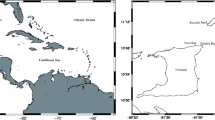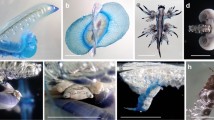Abstract
Abalones (Haliotis spp.) and sea urchins (Strongylocentrotus spp.) are part of the subtidal fauna in the kelp bed off Hopkins Marine Station, Pacific Grove, California, USA, a protected marine reserve. Although these animals have been preyed upon by sea otters for over 10 years, their densities are gubstantial (Haliotis spp.: 0.21/m2; Strongylocentrotus spp.: 0.22/m2), and two species, H. rufescens (Swainson) and S. purpuratus (Stimpson), have wide size distributions indicating broad age ranges. Most of the adult abalones and sea urchins occur clustered deep in crevices, either as a direct result of sea-otter predation or because ample drift of algal food reduces foraging activities. Abalones tend to occur in larger crevices than sea urchins, and competition for suitable crevice space may exist among these large, invertebrate, algal-drift feeders.
Similar content being viewed by others
Literature Cited
Andrews, H. L.: The kelp beds of the Monterey region. Ecology 26, 24–37 (1945).
Boolootian, R. A., A. Farmanfarmaian and A. C. Giese: On the reproductive cycle and breeding habits of two western species of Haliotis. Biol. Bull. mar. biol. Lab., Woods Hole 122, 183–193 (1962).
Camp, D. K., S. P. Cobb and J. F. Van Breedveld: Overgrazing of seagrasses by a regular urchin, Lytechinus variegatus. Bioscience 23, 37–38 (1973).
Cox, K. W.: California abalones, family Haliotidae. Calif. Fish Game Fish. Bull. 118, 1–133 (1962).
Dayton, P. K., R. J. Rosenthal and L. C. Mahan:Kelp communities in the Chilean archipelago: R/V Hero Cruise 72-5. Antarctic J. U.S. 8 (2), 34–35 (1973).
Ebert, E. E.: A food habits study of the southern sea otter, Enhydra lutris nereis. Calif. Fish Game 54, 33–42 (1968a).
— California sea otter — census and habitat survey. Underwat. Naturalist 5 (3), 20–23 (1968b).
Ebert, T. A.: Negative growth and longevity in the purple sea urchin Strongylocentrotus purpuratus (Stimpson). Science, N. Y. 157, 557–558 (1967).
— Growth rates of the sea urchin Strongylocentrotus purpuratus related to food availability and spine abrasion. Ecology 49, 1075–1091 (1968).
Faro, J. B.: A survey of subtidal sea otter habitat off Point Piños, California. M.S. thesis, 278 pp. Humboldt State College: 1970.
Fuji, A.: Ecological studies on the growth and food consumption of Japanese common littoral sea urchin, Strongylocentrotus intermedius (A. Agassiz). Mem. Fac. Fish. Hokkaido Univ. 15, 83–160 (1967).
Hall, K. R. L. and G. B. Schaller: Tool-using behavior of the California sea otter. J. Mammal. 45, 287–298 (1964).
Himmelman, J. H. and D. H. Steele: Food and predators of the green sea urchin Strongylocentrotus droebachiensis in Newfoundland waters. Mar. Biol. 9, 315–322 (1971).
Kain, J. M. and N. S. Jones: Algal colonization after removal of Echinus. In: Proceedings of the 5th International Seaweed Symposium 1965, pp 139–140. New York: Pergamon Press 1966.
Kensler, C. B. and D. J. Crisp:The colonization of artificial crevices by marine invertebrates. J. Anim. Ecol. 34, 507–516 (1965).
Kitching, J. A. and F. J. Ebling: The ecology of Lough Ine XI. The control of algae by Paracentrotus lividus. J. Anim. Ecol. 30, 373–383 (1961).
Leighton, D. L.: Studies of food preferences in algivorous invertebrates of Southern California kelp beds. Pacif. Sci. 20, 104–113 (1966a).
—: Abalone populations at Point Loma. In: Kelp habitat improvement project, Annual Report, 1965–1966, p. 83. Ed. by W. J. North. Pasadena, California: California Institute of Technology 1966b.
Leighton, D. L.: A comparative study of food selection and nutrition in the abalone, Haliotis rufescens (Swaison), and the sea urchin, Strongylocentrotus purpuratus (Stimpson). Doctoral Dissertation, 197 pp. University of California, San Diego: 1968.
— Grazing activities of benthic invertebrates in Southern California. In: Biology of giant kelp beds (Macrocystis) in California, pp 421–453. Ed. by W. J. North. Lehre, Germany: J. Cramer 1971.
—, L. G. Jones and W. J. North: Ecological relationships between giant kelp and sea urchins in Southern California. In: Proceedings of the 5th International Seaweed Symposium 1965, pp 141–153. New York: Pergamon Press 1966a.
——— and E. K. Anderson: Miscellaneous ecological observations. In: Kelp habitat improvement project, Annual Report, 1965–1966, pp 84–85. Ed. by W. J. North. Pasadena, California: California Institute of Technology 1966b.
Mann, K. H. and P. A. Breen: The relation between lobster abundance, sea urchins, and kelp beds. J. Fish. Res. Bd Can. 29, 603–609 (1972).
McLean, J. H.: Sublittoral ecology of kelp beds of the open coast areas near Carmel, California. Biol. Bull. mar. biol. Lab., Woods Hole 122, 95–114 (1962).
Miller, R. J., K. H. Mann and D. J. Scarratt: Production potential of a seaweed-lobster community in Eastern Canada. J. Fish. Res. Bd Can. 28, 1733–1738 (1971).
Muntz, L., F. J. Ebling and J. A. Kitching: The ecology of Lough Ine XIV. Predatory activity of large crabs. J. Anim. Ecol. 34, 315–329 (1965).
North, W. J.: Urchin predation. In: Kelp habitat improvement project, Annual Report, 1964–1965, pp 57–59. Ed. by W. J. North. Pasadena, California: California Institute of Technology 1965.
— and J. S. Pearse: Sea urchin population explosion in Southern California coastal waters. Science, N.Y. 167, p. 209 (1970).
Odemar, M. W. and K. C. Wilson: Population studies of sea otters in California. In MRR Ref. No. 70-3, 10 pp. Menlo Park, California: California Dept. Fish and Game 1969.
Olsen, D. A.: Banding patterns in Haliotis — II Some behavioral considerations and the effect of diet on shell coloration for Haliotis rufescens, H. corrugata, H. sorenseni, and H. assimilis. Veliger 11, 135–139 (1968).
Paine, R. T. and R. L. Vadas: The effects of grazing by sea urchins, Strongylocentrotus spp., on benthic algal populations. Limnol. Oceanogr. 14, 710–719 (1969).
Pearse, J. S.: Further observations on the reproduction of s urchins. In: Kelp habitat improvement project, Annual Report, 1970–1971, pp 108–115. Ed. by W. J. North. Pasadena, California: California Institute of Technology 1971.
—, M. E. Clark, D. L. Leighton, C.T. Mitchell, and W. J. North: Marine waste-disposal and sea urchin ecology. Appendix to: Kelp habitat improvement project, Annual Report, 1969–1970, pp 1–87. Ed. by W. J North. Pasadena, California: California Institute of Technology 1970.
Poore, G. C. B.: Ecology of New Zealand abalones, Haliotis species (Mollusca: Gastropoda) 1. Feeding. N. Z. Jl mar. Freshwat. Res. 6, 11–22 (1972).
Rosenthal, R. J. and J. R. Chess: A predator-prey relationship between the leather star Dermasterias imbricata and the purple urchin, Strongylocentrotus purpuratus. Fish. Bull. U.S. 70, 205–216 (1972).
Shepherd, S. A.: Competition between sea urchins and abalone. Aust. Fish. 32 (6), 4–7 (1973).
Swan, E. F.: Some observations on the growth rate of sea urchins in the genus Strongylocentrotus. Biol. Bull. mar. biol. Lab., Woods Hole 120, 420–427 (1961).
Swan, E. F. Growth, autonomy, and regeneration. In: Physiology of Echinodermata, pp 397–434. Ed. by R. A. Boolootian. New York: John Wiley & Sons 1966.
Vacquier, V. D.: Studies of urchin movements. In:Kelp habitat improvement project, Annual Report, 1964–1965, pp 55–55. Ed. by W. J. North. Pasadena, California: California Institute of Technology 1965.
Young, J. S. and J. D. DeMartini: The reproductive cycle, gonadal histology, and gametogenesis of the red abalone, Haliotis rufescens (Swainson). Calif. Fish Game 56, 298–309 (1970).
Author information
Authors and Affiliations
Additional information
Communicated by J. Bunt, Miami
Rights and permissions
About this article
Cite this article
Lowry, L.F., Pearse, J.S. Abalones and sea urchins in an area inhabited by sea otters. Mar. Biol. 23, 213–219 (1973). https://doi.org/10.1007/BF00389487
Accepted:
Issue Date:
DOI: https://doi.org/10.1007/BF00389487




